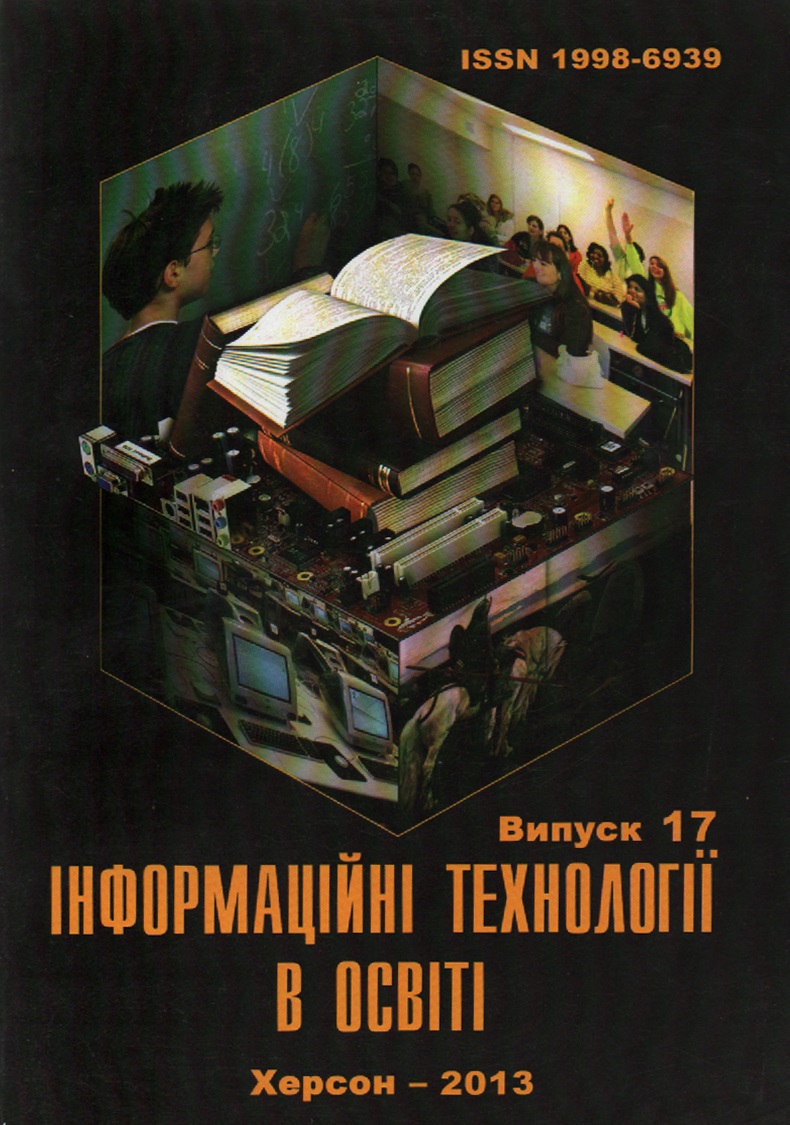USE OF CLOUD COMPUTING FOR DEVELOPMENT OF TEACHERS’ INFORMATION AND COMMUNICATION COMPETENCE
DOI:
https://doi.org/10.14308/ite000454Keywords:
Cloud computing, cloud technology, professional development of teachers, teacher information and communication competence, software, software as a serviceAbstract
The article deals with the problem for development of techers’ information and communication competence and use of cloud computing for it. The analysis of the modern approaches to the use of cloud technologies and projects for professional development of teachers and development of teachers’ information and communication competence have been presented.There are the main characteristics of software as a service on the Internet for education leading companies Google, Microsoft, IBM. There are described some actions of these companies,which are conducted to help teachers to master cloud technology for improving the professional activities and development of teachers’ information and communication competence. The examples of ways of development of teachers’ information and communication competence and training teachers to use modern ICT in the professional activity are given in the paper. The Cloud based model for development of teachers’ information and communication competence has been proposed.
Downloads
Metrics
References
1. Fourth International Conference on Microsoft “Education in the 21st century. The transformation of education in the information society: http://www.microsoft.com/Rus/Edu2010/Default.mspx. (29.04.2010)
2. Bykov V. Yu.: Models of the Open Education Organizational Systems: Monograph. – Kyiv: Atika,– 684 p. (2009) (In Ukrainian)
3. Justin Reich, Thomas Daccord, Alan November. Best Ideas for Teaching with Technology: A Practical Guide for Teachers, by Teachers. New York: M.E. Sharpe,– 291 p. (2008)
4. Virginia A. Scott. Google. Corporations that changed the world. USA: Greenwood Publishing Group, – 153 p. (2008)
5. Alec M. Bodzin, Beth Shiner Klein, Starlin Weaver. The Inclusion of Environmental Education in Science Teacher Education. USA: Springer,– 352 p. (2010)
6. Kogan L.N.: Culture in conditions of scientific and technological revolution. – Saratov: University Press, – 153 p. (1987) (In Russian)
7. Defenition and Selection of Competencies: Theoretical and Conceptual Foundations (DeSeCo). Revised December: http://www.oecd.org/education skills-beyond-school/41529556.pdf. (2001)
8. Soroko N.V.: Didactics functions of information and communication technologies in the professional activity of teacher philologist. Information technology and learning tools - Issue 1. - S. 45: http://www.nbuv.gov.ua/e-journals/ITZN/em5/emg.html (2008) (In Ukrainian)
9. UNESCO ICT Competency Framework for Teachers: http://unesdoc.unesco.org/images/0021/002134/213475e.pdf (2011)
10. Guizzardi, R. S. S., Aroyo, L., Wagner, G. Agent-oriented Knowledge Management in Learning Environments: A Peer-to-Peer Helpdesk Case Study. In [8]. ― 57–72 pp.
11. Michael Miller. Cloud Computing: Web-Based Applications That Change the Way You Work and Collaborate Online. Que Publishing– 312 р. (2008)
12. William Y. Chang, Hosame Abu-Amara, Jessica Sanford. Transforming Enterprise Cloud Services. Springer 428 p. (2010)
13. Tejaswi Redkar, Tony Guidici. Windows Azure Platform. Second edition: Apress – 650 p. (2011)
14. Soroko N.V., Shynenko M.A.: Future Development of Softwarre as a Service to Create Documents of Electronic Libraries by the Example of MICROSOFT OFFICE 365. Pedagogical Sciences of Ukraine - Volume 26, № 6: http://www.nbuv.gov.ua/e-journals/ITZN/em5/emg.html (2011) (In Ukrainian)
15. Fundacion German Sanchez Ruiperez and IBM Implement a Cloud Computing Solution for Education: http://goliath.ecnext.com/coms2/gi_0199-13346074/Fundacion-German-Sanche....
</uk>
<en>
1. Fourth International Conference on Microsoft “Education in the 21st century. The transformation of education in the information society: http://www.microsoft.com/Rus/Edu2010/Default.mspx. (29.04.2010)
2. Bykov V. Yu.: Models of the Open Education Organizational Systems: Monograph. – Kyiv: Atika,– 684 p. (2009) (In Ukrainian)
3. Justin Reich, Thomas Daccord, Alan November. Best Ideas for Teaching with Technology: A Practical Guide for Teachers, by Teachers. New York: M.E. Sharpe,– 291 p. (2008)
4. Virginia A. Scott. Google. Corporations that changed the world. USA: Greenwood Publishing Group, – 153 p. (2008)
5. Alec M. Bodzin, Beth Shiner Klein, Starlin Weaver. The Inclusion of Environmental Education in Science Teacher Education. USA: Springer,– 352 p. (2010)
6. Kogan L.N.: Culture in conditions of scientific and technological revolution. – Saratov: University Press, – 153 p. (1987) (In Russian)
7. Defenition and Selection of Competencies: Theoretical and Conceptual Foundations (DeSeCo). Revised December: http://www.oecd.org/education skills-beyond-school/41529556.pdf. (2001)
8. Soroko N.V.: Didactics functions of information and communication technologies in the professional activity of teacher philologist. Information technology and learning tools - Issue 1. - S. 45: http://www.nbuv.gov.ua/e-journals/ITZN/em5/emg.html (2008) (In Ukrainian)
9. UNESCO ICT Competency Framework for Teachers: http://unesdoc.unesco.org/images/0021/002134/213475e.pdf (2011)
10. Guizzardi, R. S. S., Aroyo, L., Wagner, G. Agent-oriented Knowledge Management in Learning Environments: A Peer-to-Peer Helpdesk Case Study. In [8]. ― 57–72 pp.
11. Michael Miller. Cloud Computing: Web-Based Applications That Change the Way You Work and Collaborate Online. Que Publishing– 312 р. (2008)
12. William Y. Chang, Hosame Abu-Amara, Jessica Sanford. Transforming Enterprise Cloud Services. Springer 428 p. (2010)
13. Tejaswi Redkar, Tony Guidici. Windows Azure Platform. Second edition: Apress – 650 p. (2011)
14. Soroko N.V., Shynenko M.A.: Future Development of Softwarre as a Service to Create Documents of Electronic Libraries by the Example of MICROSOFT OFFICE 365. Pedagogical Sciences of Ukraine - Volume 26, № 6: http://www.nbuv.gov.ua/e-journals/ITZN/em5/emg.html (2011) (In Ukrainian)
15. Fundacion German Sanchez Ruiperez and IBM Implement a Cloud Computing Solution for Education: http://goliath.ecnext.com/coms2/gi_0199-13346074/Fundacion-German-Sanche....
</en>
Downloads
Published
How to Cite
Issue
Section
License
This work is licensed under a Creative Commons Attribution-NonCommercial-ShareAlike 4.0 International License.






























